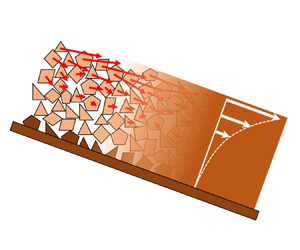Article contents
Analytic inclined flow rule for determining granular rheology under strong non-local effects
Published online by Cambridge University Press: 23 October 2023
Abstract

This study theoretically establishes a flow rule for a granular flow down a rough inclined plane, capable of determining granular rheology in the presence of strong non-local effects resulting from grain cooperativity. To describe the non-local rheology, a Landau–Ginzburg model is formulated in terms of the fluidisation parameter represented by the granular inertial number. The exact solutions of the inertial-number field are solved and provide physical insights into the evolution of the internal rheology and the flow arrest process controlled by the flow height. Through asymptotic analysis in the regime dominated by strong non-locality, the exact solutions are further reduced to yield an analytical flow rule for the mean flow velocity. A comparison between the prediction of the flow rule and experimental data from the literature for sand grains determines the underlying rheology law and the relevant rheological parameters. Thus, the proposed flow rule serves as an effective tool for inferring granular rheology from strongly non-local inclined flow data, surpassing the limitations of the classical flow rule deduced from the local rheology framework.
JFM classification
- Type
- JFM Papers
- Information
- Copyright
- © The Author(s), 2023. Published by Cambridge University Press
References
- 1
- Cited by



